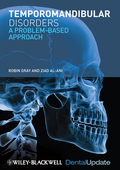
A quick, systematic and logical approach to diagnosing and treating temporomandibular disorders (TMD), this latest book in the Dental Update series is an essential clinical companion for dental students and practising dentists. Starting with an overview of the basic principles of TMD, such as the anatomy of the temporomandibular joint and its physiology and pathology in relation to clinical treatment, the book goes on to present the realities of managing patients, using a case-based approach to help readers understand and engage with the information. Each later chapter presents a different problem in the form of a case study, and each study features a systematic approach to aid learning. Temporomandibular Disorders: A Problem-Based Approach promotes learning as a dynamic process of active involvement. It encourages valuation by self-assessment with questions at the end of the book, and a unique link to an online interactive quiz where readers can test their knowledge of TMD. The final chapters include practical guides of how to make splints and samples of patient informationsheets that can be used as templates. The book is illustrated in full colour,with helpful clinical images and diagrams. KEY FEATURES Uses a case-based approach to promote effective management of TMD Covers basic scientific background as well as clinical scenarios Addresses not only why but also how with a highly practical focus Includes a unique link to an online interactive quiz (visit www.wiley.com/go/gray) Contains many full colour clinical images and diagrams INDICE: Preface. Acknowledgements. 1 About the Book. About temporomandibular disorders: what is a TMD? 2 Clinical Aspects of Anatomy, Function, Pathology and Classification. The joint anatomy, histology, structure, capsule, synovial membrane and fluid, ligaments. The intra-articular disc (meniscus). The bones of the temporomandibular joint. Mandibular (jaw/masticatory) muscles. Classification and Pathology. Further reading. 3 Articulatory System Examination. Examination of the temporomandibular joints. Mandibular (masticatory) muscle tenderness. Signs of bruxism. Further reading. 4 Ive Got TMJ! History. Examination. Special tests. Differential diagnosis. Management. Further reading. 5 Ive Got a Clicking Joint. History. Examination. Other special tests. Treatment. The patient journey. Further reading. 6 Ive Got a Locking Joint. History. Examination. Diagnosis. Treatment. TMJ locking. Further reading. 7 Ive Got a GratingJoint. Examination. Diagnosis. Treatment. Final treatment plan. Further reading. 8 Youve Changed My Bite. History. Examination. Treatment. Discussion. Further reading. 9 Ive Got Pain in My Face. History. Examination. Differential diagnosis. Treatment. Questions to ask patients regarding pain in general. Further reading. 10 Ive Got a Dislocated Jaw. Examination. Likely diagnoses. Management. Further reading. 11 My Teeth Are Worn. History. Examination. Diagnosis. Treatment. Important considerations in tooth surface loss. Further reading. 12 Ive Got a Headache. Examination. Radiographs. Articulatory system exam. Likelydiagnosis. Management. Patient journey. Further reading. 13 Ive Got Whiplash.Examination. Record keeping. Are TMD and whiplash related? Likely diagnosis. Management. Further reading. 14 Whats of Use to Me in Practice? Counselling and reassurance. Drug therapy. Physiotherapy. Splint therapy. Mouth prop. Occlusal adjustments. Radiographs. Further referral. Further reading. 15 You and theLawyer. Case scenario 1: note and record keeping. Case scenario 2: a medical report request. Case scenario 3: a disgruntled patient. Further reading. 16 The Referral Letter. Details. History. Request. Further reading. 17 How to Make a Splint. How do you make a stabilisation splint? Fitting a stabilisation splint. How do you make an anterior repositioning splint? Further reading. 18 Patient Information. Stabilisation splint. Anterior repositioning splint. General advice for patients with a TMD. Exercise programme for patients with TMD. 19 Glossary of Terms. 20 Short Answer Questions. Index.
- ISBN: 978-1-4051-9958-2
- Editorial: Wiley-Blackwell
- Encuadernacion: Rústica
- Páginas: 224
- Fecha Publicación: 01/04/2011
- Nº Volúmenes: 1
- Idioma: Inglés
